Development of a Network of Accurate Ozone Sensing Nodes for Parallel Monitoring in a Site Relocation Study
Abstract
1. Introduction
1.1. Ozone Pollution
1.2. Regulation
1.3. Ozone Levels in the South Coast Air Basin and Monitoring in the San Bernardino Mountains
1.4. Evaluation of Ozone Sensing Technology
2. Materials and Methods
2.1. Node Design and Development
2.2. Nodes’ Deployment
2.3. Data Processing and Analysis
3. Results and Discussion
3.1. Pre-Deployment Co-location Period at Crestline
3.2. Post-Deployment Co-location Period at Crestline
3.3. Results from Deployment
4. Conclusions
Supplementary Materials
Author Contributions
Funding
Acknowledgments
Conflicts of Interest
References
- Gilliland, F.D.; Berhane, K.; Rapaport, E.B.; Thomas, D.C.; Avol, E.; Gauderman, W.J.; London, S.J.; Margolis, H.G.; McConnell, R.; Islam, K.T.; et al. The effects of ambient air pollution on school absenteeism due to respiratory illnesses. Epidemiology 2001, 12, 43–54. [Google Scholar] [CrossRef] [PubMed]
- Park, H.; Lee, B.; Ha, E.H.; Lee, J.T.; Kim, H.; Hong, Y.C. Association of air pollution with school absenteeism due to illness. Arch. Pediatr. Adolesc. Med. 2002, 156, 1235–1239. [Google Scholar] [CrossRef] [PubMed]
- Romieu, I.; Lugo, M.C.; Velasco, S.R.; Sanchez, S.; Meneses, F.; Hernandez, M. Air-Pollution and School Absenteeism Among Children in Mexico City. Am. J. Epidemiol. 1992, 136, 1524–1531. [Google Scholar] [CrossRef] [PubMed]
- Jerrett, M.; Burnett, R.T.; Pope, C.A.; Ito, K.; Thurston, G.; Krewski, D.; Shi, Y.L.; Calle, E.; Thun, M. Long-Term Ozone Exposure and Mortality. N. Engl. J. Med. 2009, 360, 1085–1095. [Google Scholar] [CrossRef] [PubMed]
- Turner, M.C.; Jerrett, M.; Pope, C.A.; Krewski, D.; Gapstur, S.M.; Diver, W.R.; Beckerman, B.S.; Marshall, J.D.; Su, J.; Crouse, D.L.; et al. Long-Term Ozone Exposure and Mortality in a Large Prospective Study. Am. J. Respir. Crit. Care Med. 2016, 193, 1134–1142. [Google Scholar] [CrossRef]
- Song, W.M.; Liu, Y.; Liu, J.Y.; Tao, N.N.; Li, Y.F.; Liu, Y.; Wang, L.X.; Li, H.C. The burden of air pollution and weather condition on daily respiratory deaths among older adults in China, Jinan from 2011 to 2017. Medicine 2019, 98, 9. [Google Scholar] [CrossRef]
- Cohen, A.J.; Brauer, M.; Burnett, R.; Anderson, H.R.; Frostad, J.; Estep, K.; Balakrishnan, K.; Brunekreef, B.; Dandona, L.; Dandona, R.; et al. Estimates and 25-year trends of the global burden of disease attributable to ambient air pollution: An analysis of data from the Global Burden of Diseases Study 2015. Lancet 2017, 389, 1907–1918. [Google Scholar] [CrossRef]
- Berhane, K.; Chang, C.C.; McConnell, R.; Gauderman, W.J.; Avol, E.; Rapapport, E.; Urman, R.; Lurmann, F.; Gilliland, F. Association of Changes in Air Quality With Bronchitic Symptoms in Children in California, 1993–2012. JAMA J. Am. Med. Assoc. 2016, 315, 1491–1501. [Google Scholar] [CrossRef]
- Gauderman, W.J.; Urman, R.; Avol, E.; Berhane, K.; McConnell, R.; Rappaport, E.; Chang, R.; Lurmann, F.; Gilliland, F. Association of Improved Air Quality with Lung Development in Children. N. Engl. J. Med. 2015, 372, 905–913. [Google Scholar] [CrossRef]
- Ashmore, M.R. Assessing the future global impacts of ozone on vegetation. Plant Cell Environ. 2005, 28, 949–964. [Google Scholar] [CrossRef]
- Bytnerowicz, A.; Arbaugh, M.; Schilling, S.; Fraczek, W.; Alexander, D. Ozone distribution and phytotoxic potential in mixed conifer forests of the San Bernardino Mountains, Southern California. Environ. Pollut. 2008, 155, 398–408. [Google Scholar] [CrossRef] [PubMed]
- Godish, T. Air Quality, 3rd ed.; Lewis Publishers: Boca Raton, FL, USA; New York, NY, USA, 1997. [Google Scholar]
- Duenas, C.; Fernandez, M.C.; Canete, S.; Carretero, J.; Liger, E. Analyses of ozone in urban and rural sites in Malaga (Spain). Chemosphere 2004, 56, 631–639. [Google Scholar] [CrossRef] [PubMed]
- Air Quality Management Plan (AQMP); South Coast Air Quality Management District: Diamond Bar, CA, USA, 2016.
- Lu, R.; Turco, R.P. Air Pollutant Transport in a Coastal Environment-II. 3-Dimensional Simulations over Los Angeles Basin. Atmos. Environ. 1995, 29, 1499–1518. [Google Scholar] [CrossRef]
- Sadighi, K.; Coffey, E.; Polidori, A.; Feenstra, B.; Lv, Q.; Henze, D.K.; Hannigan, M. Intra-Urban Spatial Variability of Surface Ozone in Riverside, CA: Viability and Validation of Low-cost Sensors. Atmos. Meas. Tech. 2018, 11, 1777–1792. [Google Scholar] [CrossRef]
- Site Relocation and Parallel Monitoring Guidelines; Air Monitoring Technical Advisory Committee, California Air Resources Board: Sacramento, CA, USA, 1997.
- AirNow. Air Quality Index (AQI) Basics. Available online: www.airnow.gov/index.cfm?action=aqibasics.aqi (accessed on 20 July 2019).
- Site Survey Report for Crestline; South Coast Air Quality Management District: Diamond Bar, CA, USA, 2018.
- Afshar-Mohajer, N.; Zuidema, C.; Sousan, S.; Hallett, L.; Tatum, M.; Rule, A.M.; Thomas, G.; Peters, T.M.; Koehler, K. Evaluation of low-cost electro-chemical sensors for environmental monitoring of ozone, nitrogen dioxide, and carbon monoxide. J. Occup. Environ. Hyg. 2018, 15, 87–98. [Google Scholar] [CrossRef]
- Mead, M.I.; Popoola, O.A.M.; Stewart, G.B.; Landshoff, P.; Calleja, M.; Hayes, M.; Baldovi, J.J.; McLeod, M.W.; Hodgson, T.F.; Dicks, J.; et al. The use of electrochemical sensors for monitoring urban air quality in low-cost, high-density networks. Atmos. Environ. 2013, 70, 186–203. [Google Scholar] [CrossRef]
- Spinelle, L.; Gerboles, M.; Aleixandre, M.; Bonavitacola, F. Evaluation of Metal Oxides Sensors for the Monitoring of O3 in Ambient Air at Ppb Level. Chem. Eng. Trans. 2016, 54. [Google Scholar] [CrossRef]
- Gerboles, M.; Buzica, D. Evaluation of Micro-Sensors to Monitor Ozone in Ambient Air; EUR 23676 EN; Joint Research Center for Environment and Sustainability: Ispra, VA, Italy, 2009. [Google Scholar] [CrossRef]
- Williams, R.D.; Vallano, A.; Polidori, S. Garvey, S. Spatial and Temporal Trends of Air Pollutants in the South Coast Basin Using Low Cost Sensors; EPA/600/R-17/463; U.S. Environmental Protection Agency: Washington, DC, USA, 2018.
- Masey, N.; Gillespie, J.; Ezani, E.; Lin, C.; Wu, H.; Ferguson, N.S.; Hamilton, S.; Heal, M.R.; Beverland, I.J. Temporal changes in field calibration relationships for Aeroqual S500 O3 and NO2 sensor-based monitors. Sens. Actuators B Chem. 2018, 273, 1800–1806. [Google Scholar] [CrossRef]
- Andersen, P.C.; Williford, C.J.; Birks, J.W. Miniature Personal Ozone Monitor Based on UV Absorbance. Anal. Chem. 2010, 82, 7924–7928. [Google Scholar] [CrossRef]
- Field Evaluation: 2B Technologies Personal Ozone Monitor (POM); Air Quality Sensor Performance Evaluation Center (AQ-SPEC), South Coast Air Quality Management District: Diamond Bar, CA, USA, 2018.
- Collier-Oxandale, A.; Feenstra, B.; Papapostolou, V.; Zhang, H.; Kuang, M.; Der Boghossian, B.; Polidori, A. Field and laboratory performance evaluations of 28 gas-phase air quality sensors by the AQ-SPEC program. Atmos. Environ. 2019, 220, 117092. [Google Scholar] [CrossRef]
- Laboratory Evaluation: 2B Technologies Personal Ozone Monitor (POM); Air Quality Sensor Performance Evaluation Center (AQ-SPEC), South Coast Air Quality Management District: Diamond Bar, CA, USA, 2018.
- Sun, L.; Wong, K.C.; Wei, P.; Ye, S.; Huang, H.; Yang, F.H.; Westerdahl, D.; Louie, P.K.K.; Luk, C.W.Y.; Ning, Z. Development and Application of a Next Generation Air Sensor Network for the Hong Kong Marathon 2015 Air Quality Monitoring. Sensors 2016, 16, 18. [Google Scholar] [CrossRef] [PubMed]
- Revision, D. (Ed.) Personal Ozone Monitor Operational Manual; 2B Technologies: Boulder, CO, USA, 2015. [Google Scholar]
- Sullivan, J.T.; McGee, T.J.; Langford, A.O.; Alvarez, R.J.; Senff, C.J.; Reddy, P.J.; Thompson, A.M.; Twigg, L.W.; Sumnicht, G.K.; Lee, P.; et al. Quantifying the contribution of thermally driven recirculation to a high-ozone event along the Colorado Front Range using lidar. J. Geophys. Res. Atmos. 2016, 121, 10377–10390. [Google Scholar] [CrossRef]
- Kang, D.W.; Mathur, R.; Rao, S.T.; Yu, S.C. Bias adjustment techniques for improving ozone air quality forecasts. J. Geophys. Res. Atmos. 2008, 113, 17. [Google Scholar] [CrossRef]
- Lee, P.; Ngan, F. Coupling of Important Physical Processes in the Planetary Boundary Layer between Meteorological and Chemistry Models for Regional to Continental Scale Air Quality Forecasting: An Overview. Atmosphere 2011, 2, 464–483. [Google Scholar] [CrossRef]
- Dabberdt, W.F.; Hales, J.; Zubrick, S.; Crook, A.; Krajewski, W.; Doran, J.C.; Mueller, C.; King, C.; Keener, R.N.; Bornstein, R.; et al. Forecast issues in the urban zone: Report of the 10th Prospectus Development Team of the US Weather Research Program. Bull. Am. Meteorol. Soc. 2000, 81, 2047–2064. [Google Scholar] [CrossRef]
- National Weather Service. National Air Quality Forecast Capability Summary. Available online: https://www.weather.gov/sti/stimodeling_airquality_summary (accessed on 26 November 2019).
- U.S Environmental Protection Agency. CMAQ: The Community Multiscale Air Quality Modeling System. Available online: https://www.epa.gov/cmaq (accessed on 27 November 2019).
- Garner, G.G.; Thompson, A.M.; Lee, P.; Martins, D.K. Evaluation of NAQFC model performance in forecasting surface ozone during the 2011 DISCOVER-AQ campaign. J. Atmos. Chem. 2015, 72, 483–501. [Google Scholar] [CrossRef][Green Version]
- Flynn, C.M.; Pickering, K.E.; Crawford, J.H.; Weinheimer, A.J.; Diskin, G.; Thornhill, K.L.; Loughner, C.; Lee, P.; Strode, S.A. Variability of O3 and NO2 profile shapes during DISCOVER-AQ: Implications for satellite observations and comparisons to model-simulated profiles. Atmos. Environ. 2016, 147, 133–156. [Google Scholar] [CrossRef]
- CFR Part 58. In Appendix D-Network Design Criteria for Ambient Air Quality Monitoring; US EPA: Washington, DC, USA, 2017.
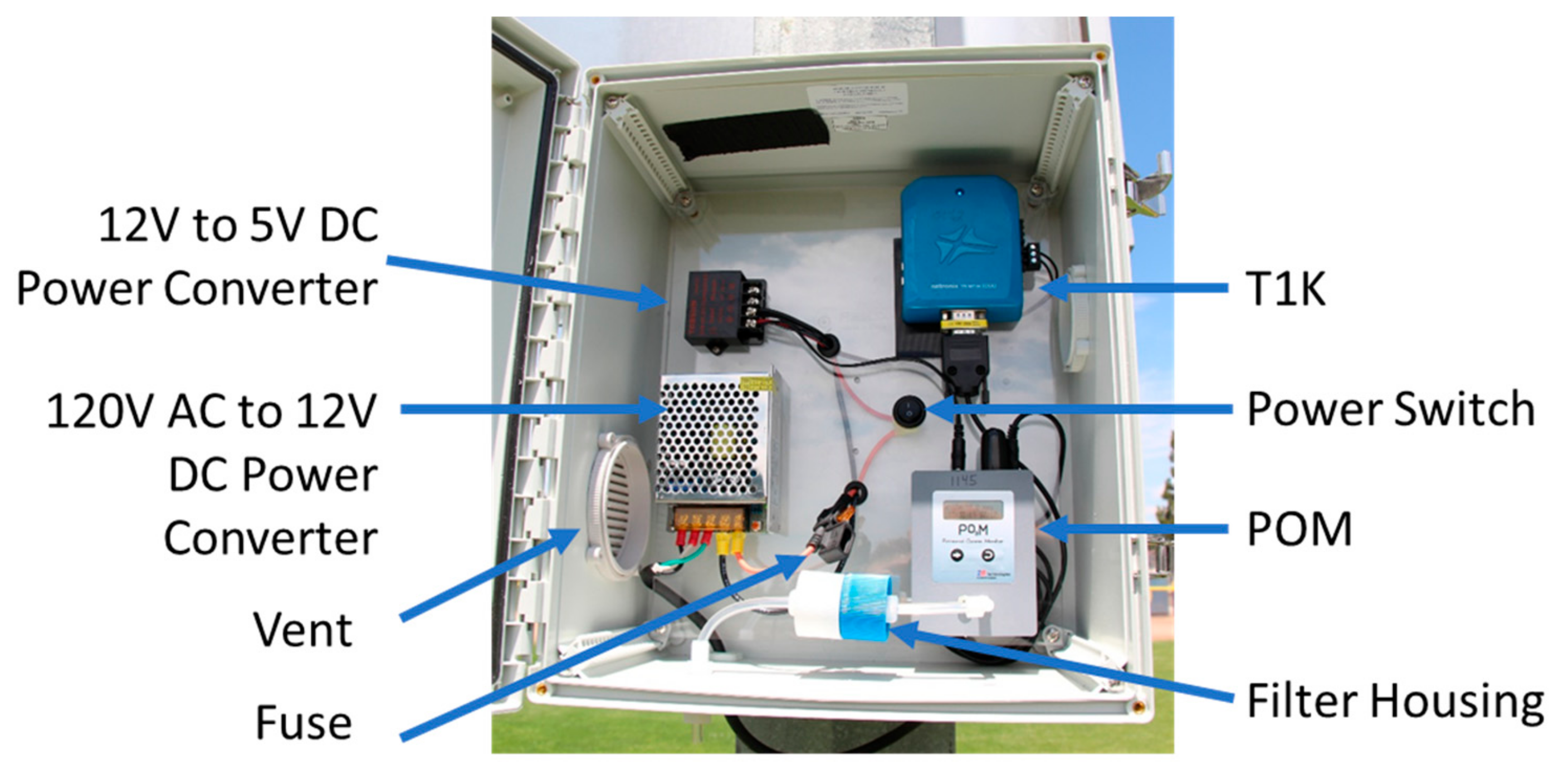
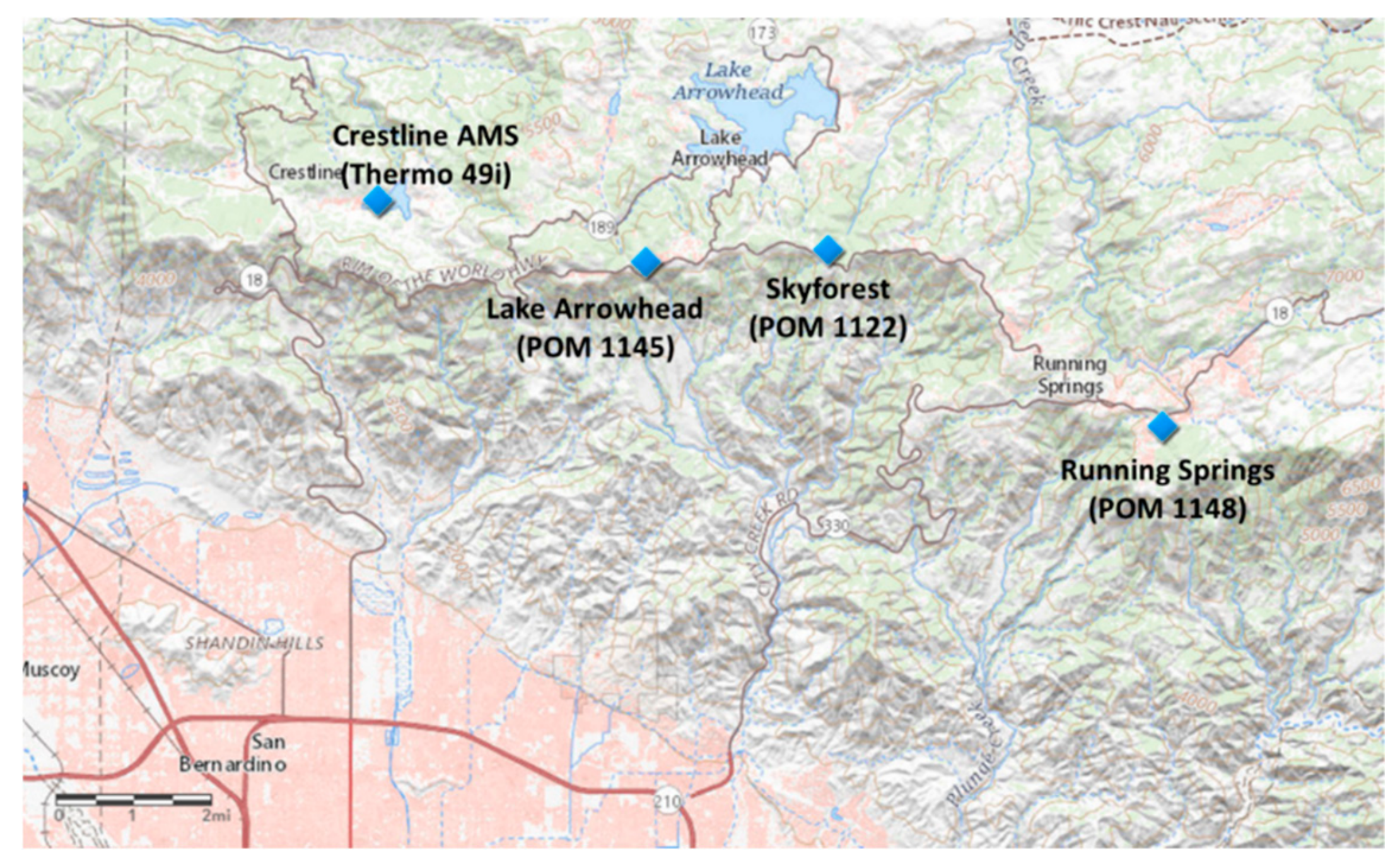

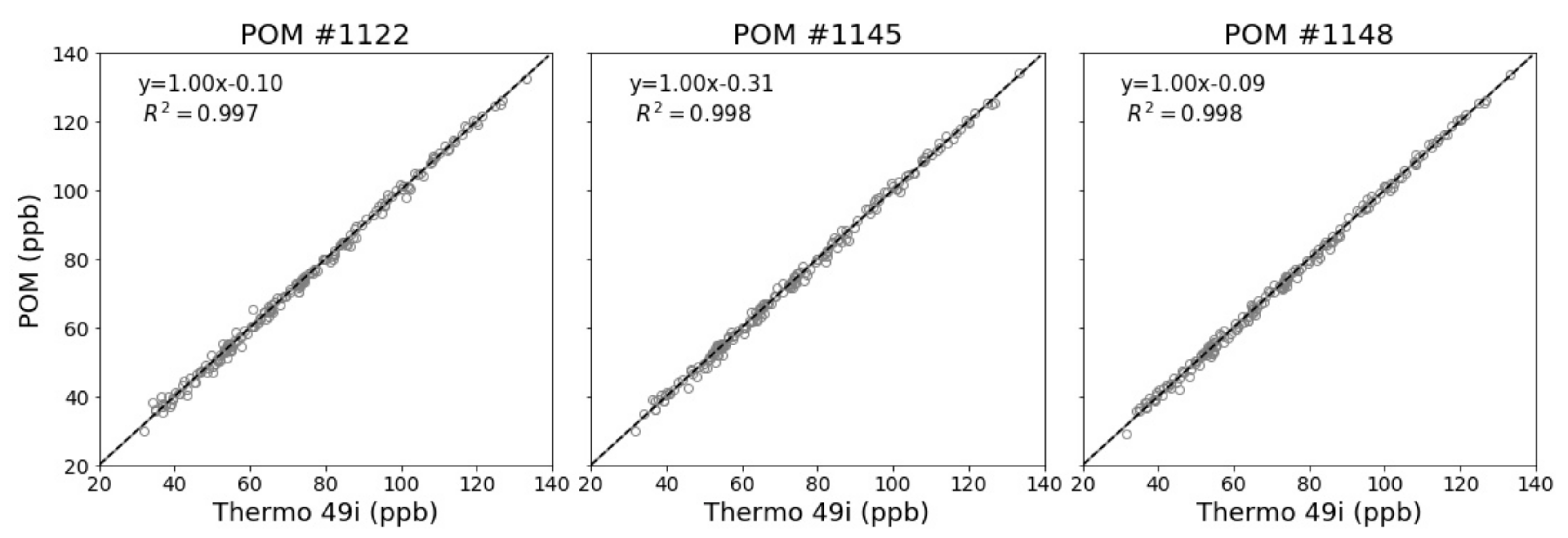
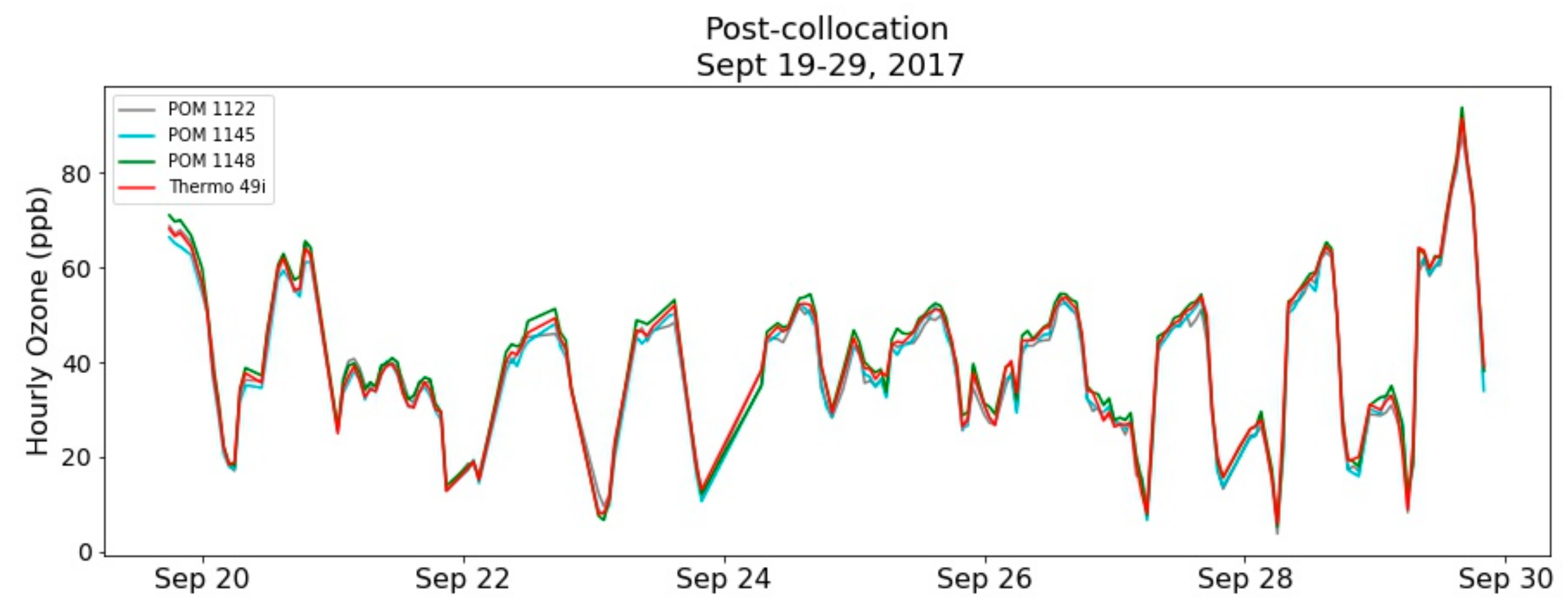

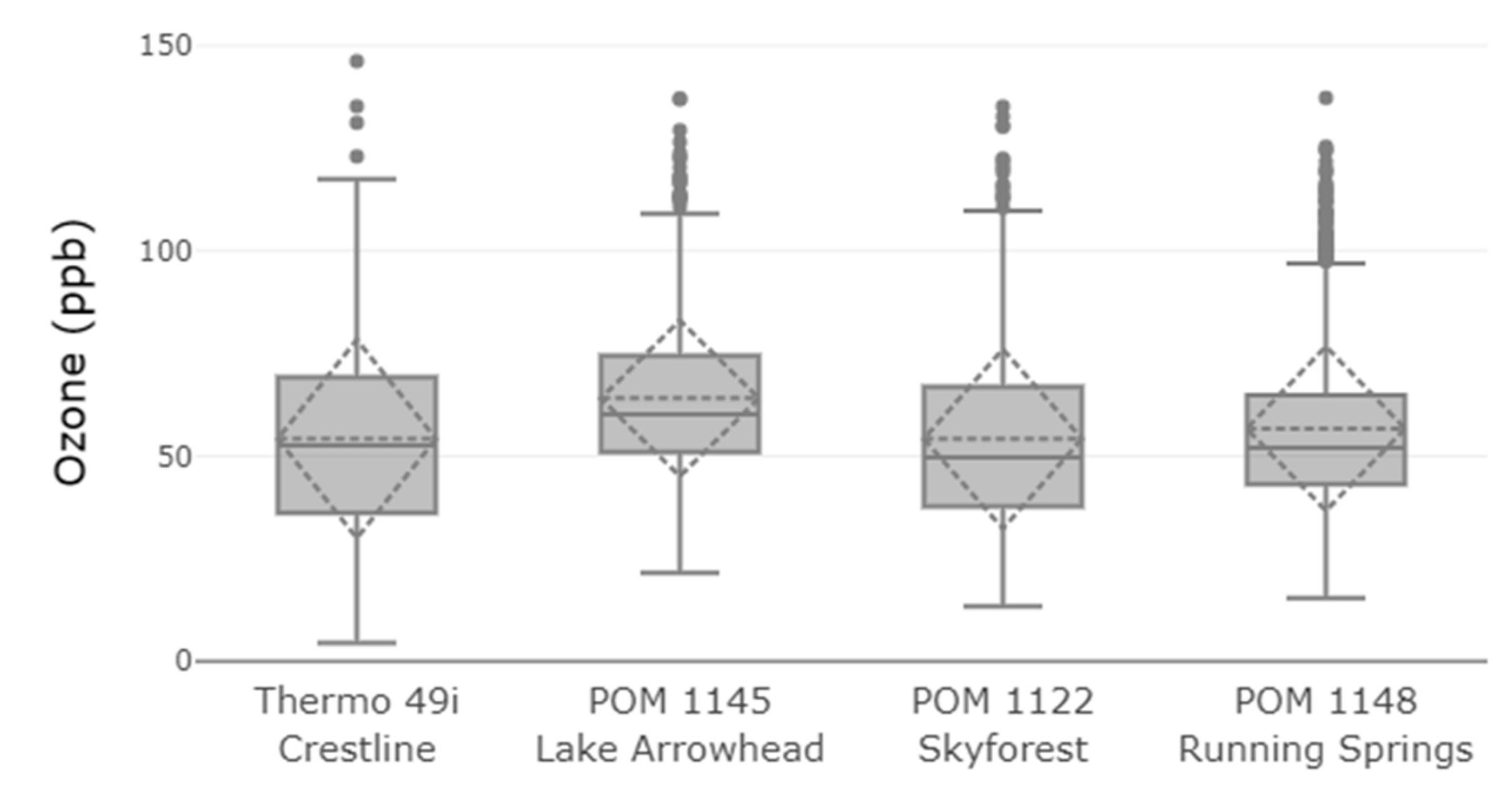
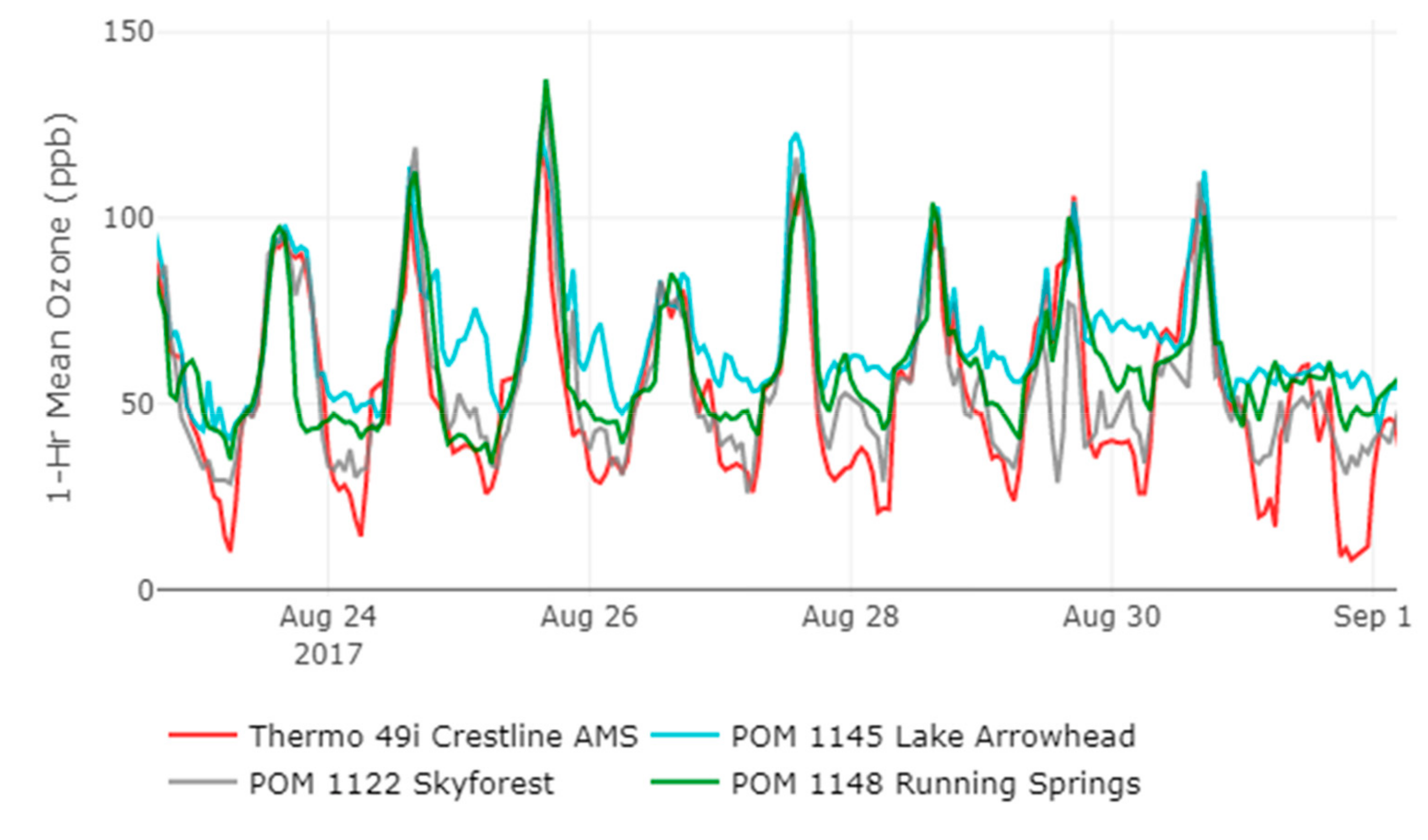
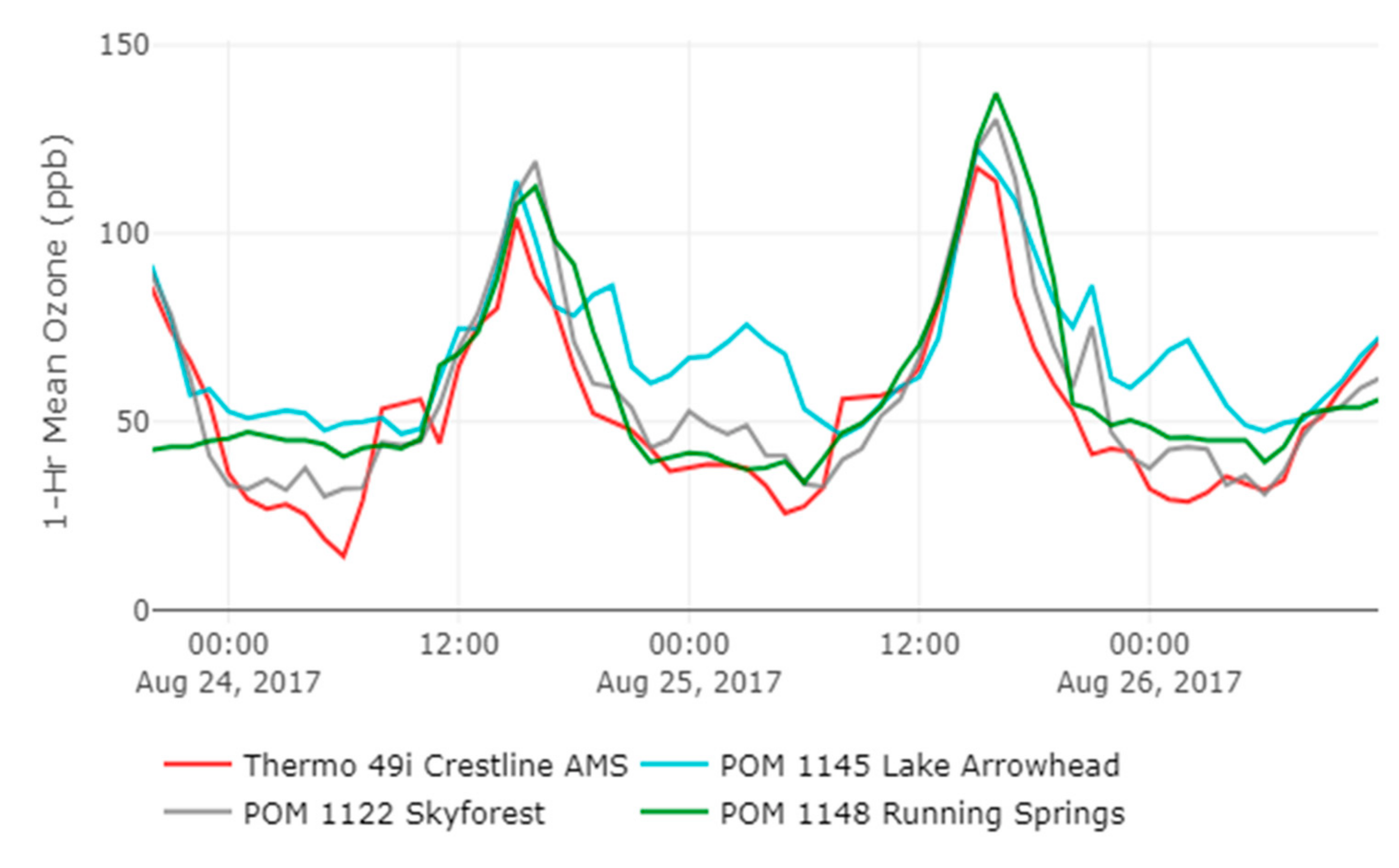
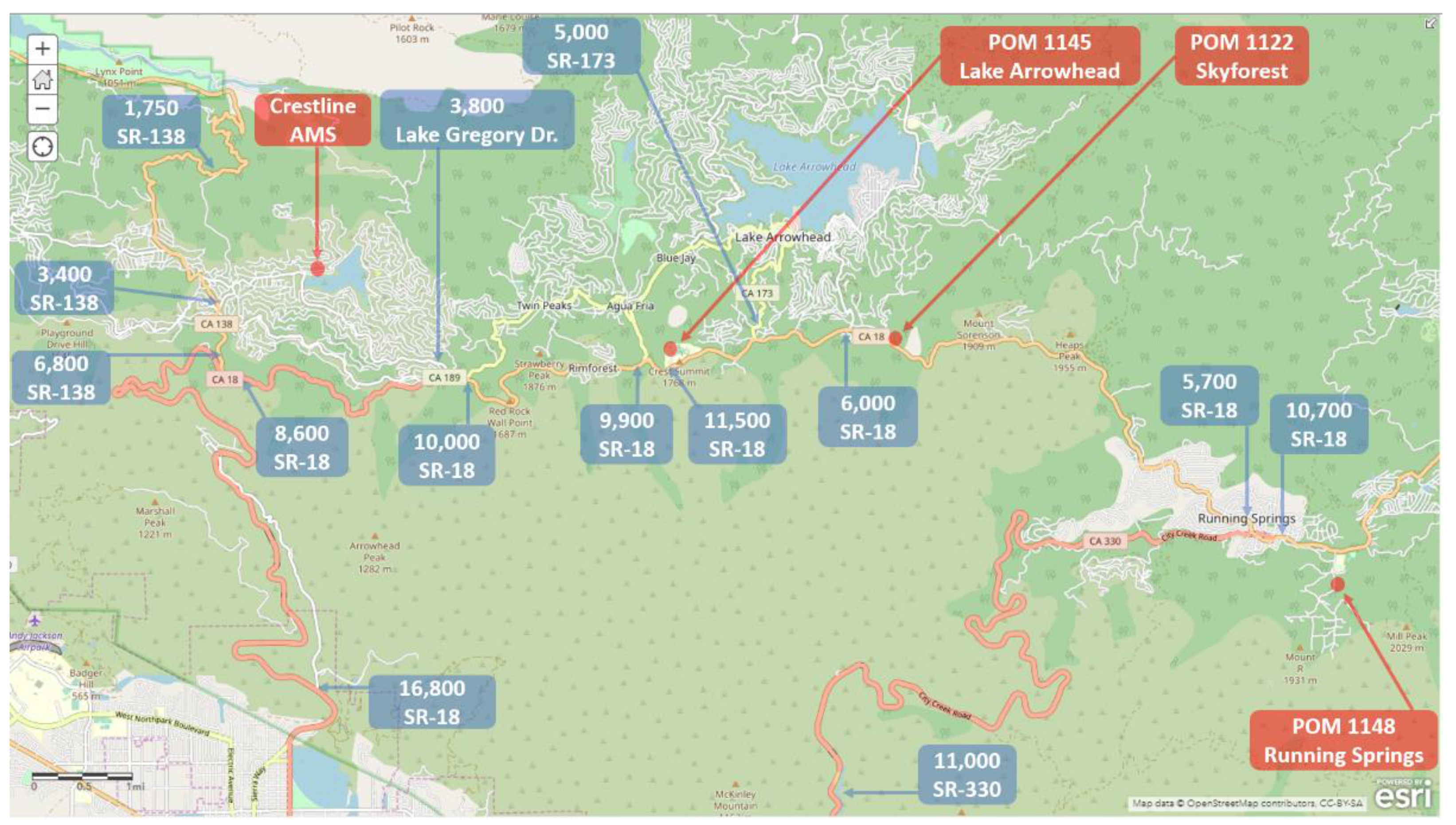
| Standard for Ozone | 1-h Average | 8-h Average (Year Established) |
|---|---|---|
| National Ambient Air Quality Standard | 120 ppb (1979) | 70 ppb (2015) 75 ppb (2008) 80 ppb (1997) |
| California Ambient Air Quality Standard | 90 ppb | - |
| Period | Dates | # of Days |
|---|---|---|
| Pre-deployment co-location | 7/11/17 to 7/19/17 | 8 |
| Deployment | 7/19/17 to 9/19/17 | 62 |
| Post-deployment co-location | 9/19/17 to 9/29/17 | 10 |
| Location | Crestline | Lake Arrowhead | Skyforest | Running Springs | |
|---|---|---|---|---|---|
| Instrument | Thermo 49i | POM 1145 | POM 1122 | POM 1148 | Units |
| Population | 10,700 | 12,400 | 300 | 4800 | no. residents |
| Elevation | 1390 | 1753 | 1733 | 1858 | m |
| Distance from Crestline AMS | 0 | 5.8 | 9.5 | 17.1 | km |
| Statistics (1-h average) | |||||
| Mean Ozone Conc. | 54.2 | 64.0 | 54.2 | 56.7 | ppb |
| Standard Deviation | 24.2 | 18.9 | 21.8 | 20.0 | ppb |
| Minimum Conc. | 4.5 | 21.5 | 13.4 | 15.4 | ppb |
| Maximum Conc. | 146.2 | 137.1 | 135.2 | 137.3 | ppb |
| Hourly data points | 1032 | 1032 | 1032 | 1032 | count |
| Slope | - | 0.65 | 0.81 | 0.62 | - |
| Intercept | - | 28.8 | 10.5 | 22.8 | - |
| R2 | - | 0.69 | 0.80 | 0.57 | - |
| Mean Bias Deviation (MBD) | - | 9.8 | 0.0 | 2.5 | ppb |
| Mean Absolute Deviation (MAD) | - | 11.7 | 8.3 | 12.1 | ppb |
| MAD—Daytime | 7.1 | 6.7 | 8.7 | ppb | |
| MAD—Nighttime | 16.7 | 10.0 | 15.9 | ppb |
| Location | Crestline | Lake Arrowhead | Skyforest | Running Springs | |
|---|---|---|---|---|---|
| Instrument | Thermo 49i | POM 1145 | POM 1122 | POM 1148 | Units |
| Mean Conc. | 100.8 | 106.9 | 101.9 | 104.6 | ppb |
| MBD | - | 6.08 | 1.08 | 3.81 | ppb |
| SD MBD | - | 8.89 | 8.29 | 11.93 | ppb |
| Lower limit of MBD (95% CI) | - | 2.10 | −2.63 | −1.53 | ppb |
| Upper Limit of MBD (95% CI) | - | 10.05 | 4.79 | 9.15 | ppb |
| Lower Limit % | - | 2.0 | −2.6 | −1.5 | % |
| Upper Limit % | - | 9.7 | 4.7 | 8.9 | % |
| Slope | - | 0.61 | 0.90 | 0.63 | - |
| Intercept | - | 45.7 | 11.3 | 41.5 | - |
| R2 | - | 0.59 | 0.70 | 0.40 | - |
| Location—Unit | No. of Exceedances (Days) |
|---|---|
| Crestline—Thermo 49i | 32 |
| Skyforest—POM 1122 | 27 |
| Lake Arrowhead—POM 1145 | 38 |
| Running Springs—POM 1148 | 28 |
© 2019 by the authors. Licensee MDPI, Basel, Switzerland. This article is an open access article distributed under the terms and conditions of the Creative Commons Attribution (CC BY) license (http://creativecommons.org/licenses/by/4.0/).
Share and Cite
Feenstra, B.; Papapostolou, V.; Der Boghossian, B.; Cocker, D.; Polidori, A. Development of a Network of Accurate Ozone Sensing Nodes for Parallel Monitoring in a Site Relocation Study. Sensors 2020, 20, 16. https://doi.org/10.3390/s20010016
Feenstra B, Papapostolou V, Der Boghossian B, Cocker D, Polidori A. Development of a Network of Accurate Ozone Sensing Nodes for Parallel Monitoring in a Site Relocation Study. Sensors. 2020; 20(1):16. https://doi.org/10.3390/s20010016
Chicago/Turabian StyleFeenstra, Brandon, Vasileios Papapostolou, Berj Der Boghossian, David Cocker, and Andrea Polidori. 2020. "Development of a Network of Accurate Ozone Sensing Nodes for Parallel Monitoring in a Site Relocation Study" Sensors 20, no. 1: 16. https://doi.org/10.3390/s20010016
APA StyleFeenstra, B., Papapostolou, V., Der Boghossian, B., Cocker, D., & Polidori, A. (2020). Development of a Network of Accurate Ozone Sensing Nodes for Parallel Monitoring in a Site Relocation Study. Sensors, 20(1), 16. https://doi.org/10.3390/s20010016






